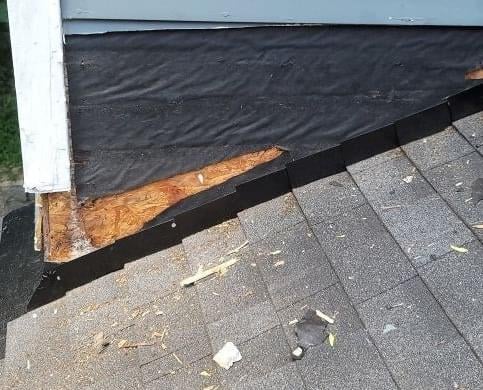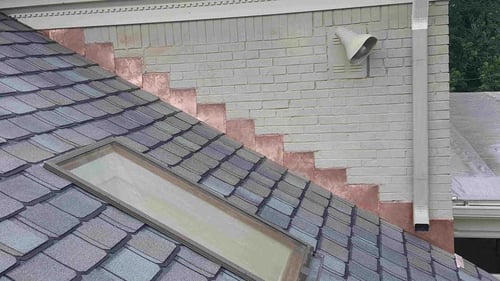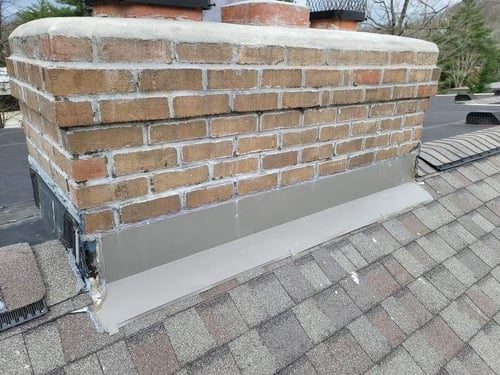There’s a lot more to your roof than the shingles you see walking down the street. It’s a combination of different materials and components that come together to protect you and your family from the elements.
One of the most crucial parts of your roof is its flashing. Without roof flashing, you, your family, valuables, and yes, even your wallet are at risk due to roof leaks.
Usually, you wouldn’t have to worry about this. But unfortunately, some roofing contractors take advantage of homeowners by completely leaving it off their estimate to lower their prices.
How can you stop this from happening to you? The best way is to know the common types of roof flashing and where they go on your roof.
At Bill Ragan Roofing Company, we use our 30 plus years of experience to help homeowners avoid being taken advantage of by the roofing industry.
This article covers the common types of roof flashing and where a roofing contractor should install them on your roof. After that, we also give you the 3 things that every homeowner needs to know about roof flashing.
By the end, you’ll be on your way to being one of the most informed homeowners in the roofing industry.
The common types of roof flashing
Roof flashing is a thin metal material that roofers install to direct water away from certain areas (walls, chimneys, roof valleys) of your roof. Like I mentioned earlier, it’s one of the most crucial roofing materials every roof needs to have.
With that in mind, there are a few different types of roof flashing that go in specific areas on your roof. The most common types are step flashing, counter flashing, and apron flashing.
Step flashing
Step flashing is primarily used against the sides of walls and chimneys. It works by placing a piece of metal (flashing) under every shingle installed right up against the side of a wall to block the water from running down into it.
 (Step flashing being installed)
(Step flashing being installed)
That’s why the term “step” is used in step flashing. You do it step by step by installing a shingle, then a piece of flashing, then another shingle, then a piece of flashing until the wall is completely protected.
Counter flashing
Counter flashing is used on walls and chimneys like step flashing. Unlike step flashing, the piece of flashing is sawed into an existing mortar joint, and the metal comes over the top of the brick.

Like step flashing, counter flashing is sometimes installed in a step-by-step method. But if it’s flashing you can actually see, it’s counter flashing.
Apron flashing
Apron flashing is used at the base of a wall or penetration. It’s shaped like an L and can be up to 14 feet in length to fit the base of the penetration.

It’s also used around dormers to prevent water from getting into your windows.
.jpg?width=500&name=Apron%20Flashing%20(2).jpg) (Apron flashing around window)
(Apron flashing around window)
3 things you need to know about roof flashing
Now you know the common types of roof flashing. But after learning the types, there are still a few things you need to know about roof flashing in general.
Let’s get to the 3 things homeowners need to know about roof flashing.
1. Roof flashing might not be replaced during a roof replacement
During the roof replacement process, most of your materials and components will be replaced. However, roof flashing is a little different.
When your local roofing contractor comes out to give you a quote for your roof replacement, they inspect your roof flashing. During their inspection, they’ll check your roof flashing for rusting and if the integrity of the metal is still strong.
No matter what they find, I always recommend replacing your roof flashing during a roof replacement. But if your contractor doesn’t see rusting and the metal’s integrity is still holding up, then your roof flashing might not have to be replaced during your replacement.
Just know that this is incredibly rare and most roof replacements require replacing the roof flashing. But there's no question that if it’s damaged, rusted, or if you’re upgrading from a 3-tab to a dimensional asphalt shingle, it will need to be replaced.
2. The types of metal roof flashing can be made of
Roof flashing comes in a few different metal options. The common types of metals used for roof flashing are aluminum, steel, or copper.
It’s completely up to you which metal you choose for roof flashing. If you’re looking for a clean look that fits most budgets, go with the most common type of metal used for roof flashing today, steel.
If you want an upgraded look, copper looks great aesthetically and will live longer but will cost you more upfront. Before deciding, talk to your local roofing contractor about which type of metal will give you the look you want while staying within your budget.
3. It’s crucial to maintain your roof flashing
I already mentioned you might not have to replace your roof flashing when you get a roof replacement. However, your roof flashing should outlive the original roof it was installed on, no matter what kind of metal is used.
With it living longer than the roof, it’s crucial to have your roof flashing inspected as part of annual roof maintenance. This allows your roofing contractor to ensure the flashing is doing its job and the metal’s integrity is holding strong.
This can also save you from costly roof repairs and help catch future roof flashing problems before they start. Because of this, inspecting your roof flashing’s integrity is crucial during an annual maintenance inspection.
What else needs to be included in your roof estimate?
Now you know the 3 things every homeowner needs to know about roof flashing. Remember, roof flashing must be included in your estimate.
If it’s able to be reused, then great. But a roofing contractor should always be upfront and tell you if they’ll reuse your old flashing or include new flashing in your roof estimate.
Speaking of roof estimates, roof flashing is just one of many things that must be included. Knowing what needs to be in an estimate is one of the best ways to figure out if you're working with a reputable roofing contractor or they’re trying to take advantage of you.
Because we want to continue helping homeowners like you prepare for their roofing project, we wrote another article explaining what must be in your roof estimate.
Since 1990, the team at Bill Ragan Roofing has helped homeowners in Nashville and surrounding Middle Tennessee areas with all of their roofing needs. Whether you need roof repairs or a full roof replacement, you can count on our high-quality workmanship backed by a lifetime warranty.
Check out What Should My Roof Estimate Include to learn what you need to be looking for when getting a quote for your new roof.



